Deep in the forests of Karelia in northwestern Russia, digging is under way to find the graves of Red Army soldiers from the World War II era that may have been executed while prisoners of war by their Finnish captors.
At least that is how the Russian Military-Historical Society (RVIO), which is carrying out the excavation work, describes the project.
"The expedition has begun," the society's spokeswoman, Nadezhda Usmanova, told RFE/RL's Russian Service. "As we announced, the work began on August 25 and it is proceeding according to our plans."
Locals, however, are concerned about the excavations. They are being carried out around the Sandarmokh memorial, which marks the mass graves of at least 9,000 victims of Soviet dictator Josef Stalin's executioners.
They suspect the Military-Historical Society's real intention is to rewrite the history of the site to cover up Stalin's crimes against his own people and to turn the location into another shrine to the achievements and sufferings of the Soviet Union during World War II.
Under President Vladimir Putin, Stalin's image has been steadily rehabilitated to emphasize his role in industrializing the country and leading it to victory over Nazi Germany while downplaying the purges, forced collectivization, mass political repressions, deportations, and labor camps that characterized his decades in power.
Putin has accused Russia's critics of using the "excessive demonization" of Stalin "to show that today's Russia carries some kind of birthmarks of Stalinism."
Sandarmokh was originally identified and studied in 1997 by prominent historian Yury Dmitriyev, who heads the Karelia branch of the Memorial human rights society. Thanks to his work, historians have identified 6,241 of the victims by name and the site has been given protected status.
Dmitriyev was arrested in December 2016 on child pornography charges that he denies. He was acquitted in April after spending 13 months in custody.
In June, authorities rearrested him and charged him the following month with committing sexual assault against his adopted daughter. The 62-year-old historian says the campaign against him is aimed at discrediting his research into Stalin's crimes because it complicates government efforts to glorify the Soviet past.
"I am mostly afraid that [the new excavations] are being done in order to discredit Yury Dmitriyev, who has devoted his entire life to establishing justice and demonstrating the scale of the victims, of the tragedy, of the actions of the Stalinist executioners," said Emilia Slabunova, head of the Karelian branch of the liberal Yabloko party, who has asked prosecutors to stop the Military-Historical Society dig.
"Their goal is to say that there were no executions of Stalinist victims but that Finnish occupiers shot Soviet prisoners of war instead. They are looking for a way to extricate themselves from this scandal."
She suggested that authorities fear their reputation "has suffered pretty significant damage because of the scandal surrounding Dmitriyev's arrest, adding, "Now they need to somehow discredit the important work that he did over more than 20 years."
The hypothesis that the bodies of executed Soviet prisoners of war could be in the area was first put forward by Yury Kilin and Sergei Verigin, historians at Petropavlovsk State University. However, they speculated that their remains would be found near Medvezhegorsk, where a POW camp was located, some 12 kilometers away from Sandarmokh.
They could not be reached for comment on this story.
"The idea was first formally put forward here in Petrozavodsk," said local journalist Gleb Yarovoi, who has been writing about Sandarmokh and Dmitriyev's work for many years. "The idea was discussed and it was decided to form an international group so that everything would be done openly, transparently, and objectively, and this group would decide about possible excavations and so on. But in the end, the authorities pushed Petropavlovsk University aside and the Russian Military-Historical Society took over the matter."
The Military-Historical Society was founded by Russian presidential decree in 2012 and is the project of Culture Minister Vladimir Medinsky and nationalist politician and Roskosmos head Dmitry Rogozin. Among other things, it sets itself the task of "educating Russian citizens, particularly youths, in the spirit of love, dedication, and selfless service to the Motherland and respect for Defenders of the Fatherland and the Armed Forces of the Russian Federation."
Medinsky, who has been a leading figure in the Kremlin's efforts to glorify Russia's imperial and Soviet past, has been criticized for, among other things, the lack of academic value of his doctoral dissertation on the topic of how foreigners purportedly propagate tendentious, biased views about Russia. In October 2017, a leading academic commission recommended that his degree be rescinded because the dissertation did not use original sources, ignored relevant research, and "said nothing new."
"Many people don't have confidence [in the Military-Historical Society], beginning with the fact that it is headed by Vladimir Medinsky, who is famous for his fake dissertation," Yarovoi said. "So now there are people with dubious reputations in professional circles working at Sandarmokh."
Military-Historical Society spokeswoman Usmanova insisted that the project is entirely aboveboard and being conducted professionally.
"We have received all the necessary documents," she told RFE/RL. "The [Military-Historical Society] is a very serious organization. Professional searchers, anthropologists, and specialists are working [at Sandarmokh]. They have all the necessary equipment."
Usmanova added that the searchers had recovered three bodies that they believe were Red Army POWs within the first few days. Two more bodies were found later.
"They were approximately the same age and height," she said of the corpses. "They were relatively young men. They were dressed in clothing of the same fabric. Their hands were tied, and they had bullet wounds to the head. Nearby, we found three shell casings that we believe were of foreign origin. An analysis is being carried out.
"Experts tell us that it is likely that they were prisoners of war," she said.
Journalist Yarovoi said he is worried that the Military-Historical Society is rushing to judgment.
"The searchers say they think the executions most likely happened in the summer because the bodies were buried at a depth of 2 or 2 1/2 meters, which is rather deep," he told RFE/RL. "No one is likely to dig that deep there in the winter. So according to them, the executions were in the summer; but then why were these people wearing overcoats and felt boots? In addition, the poses and the depth at which the bodies were found were typical for Sandarmokh victims. Soviet prisoners had their hands tied behind their backs when they were taken from Medvezhegorsk and were brought in that state to Sandarmokh to be shot, standing on their knees. There are many archive photographs in which Finns are shooting our POWs. Generally, the victims are standing with their hands tied in front. It is completely unclear what [the Military-Historical Society] has found there."
Yarovoi is convinced that the society's purpose is to "cast a shadow over Sandarmokh as a place of historical memory connected with the Great Terror."
They want to be able to claim that the bodies of Red Army soldiers are buried there in order to change the memorial from one dedicated to Stalin's victims to one honoring the military.
"That is the main idea," he said. "And it completely fits in with what is happening today [in Russia as a whole]. They are sanitizing our memory. In some cases, they destroy it. In some cases, they sow doubts..."
Irina Flige, the director of the St. Petersburg branch of Memorial, participated in the original investigations of Sandarmokh led by Dmitriyev in the 1990s. She also believes that the Military-Historical Society's aim is to muddy the legacy of the site and the reputation of Memorial.
"We talk a lot about historical memory," she said. "But I will tell you honestly -- Russia has no historical memory; these are just words that people use. We have no point or line that would separate the past from the present. We might have that if there had been an acknowledgment of the arrests and the torture and a condemnation of those who committed crimes against the nation and against humanity.
"Many years have passed, but this has not happened. So now we have people who think the Soviet terror was just a random episode, who are falsifying a criminal case against Yury Dmitriyev. That is the inheritance that we have been left."

















